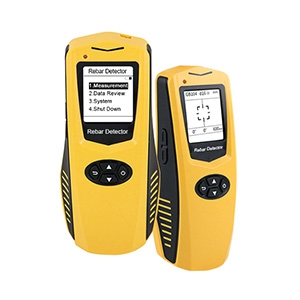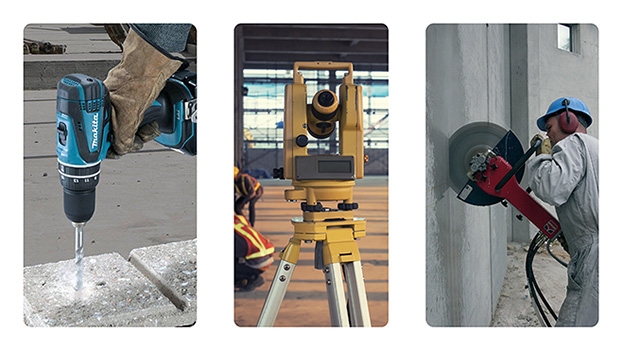In construction engineering, structural inspection, and repair, the rebar scanner (also known as a concrete rebar scanner/rebar detector) is a critical professional tool. It uses specific physical detection technologies to quickly and accurately locate the position, direction, and distribution of internal rebar within concrete structures, without causing any damage. Additionally, it can estimate the rebar's diameter and the concrete cover's thickness. This non-destructive testing method is widely applied across construction, maintenance, and safety assessment projects, significantly enhancing the safety, efficiency, and scientific rigor of operations.
In this blog by SISCO, we will comprehensively explain the definition, working principles, major types, application scenarios, operating procedures, and common mistakes associated with rebar scanners, helping readers build a complete and systematic understanding.
Definition of a Rebar Scanner
A rebar scanner is a device based on either electromagnetic induction or ground-penetrating radar (GPR) technology that detects information about rebar inside concrete structures through non-destructive means. It enables accurate measurement of the position, direction, spacing, and depth of embedded rebar, and can estimate the diameter of the rebar and the thickness of the protective concrete layer. This provides critical data for pre-construction assessment, structural safety evaluation, and maintenance or reinforcement design.
Typically, rebar locators are suitable for ordinary reinforced concrete elements, but under certain conditions, can also identify prestressed tendons and other metallic components. By using non-invasive inspection methods, the integrity of the concrete structure is preserved while greatly improving detection efficiency.
Working Principles of Rebar Scanners
According to different technological approaches, rebar scanners are mainly based on two principles: 
- Electromagnetic Induction Technology: An electromagnetic induction rebar finder generates an alternating magnetic field through a coil inside the probe. When encountering metal rebar within the concrete, induced currents are generated in the steel, altering the magnetic field characteristics received by the probe. The device analyzes these changes to determine the rebar’s position, orientation, and depth information within a certain range. The advantages of electromagnetic induction technology include lightweight equipment, simple operation, and fast response, making it suitable for quickly locating rebars. Its limitation lies in its restricted detection depth, usually not exceeding 10 centimeters, and its inability to detect non-metallic anomalies.
- Ground-Penetrating Radar (GPR) Technology: A GPR rebar scanner emits high-frequency electromagnetic pulses that penetrate the concrete and reflect when encountering different media (such as rebar). By analyzing the reflected signals, the device can generate images of the internal structure, enabling the detection of not only rebar but also pipes, voids, and other anomalies. The advantages of GPR technology include greater detection depth, which can reach several tens of centimeters, and the ability to inspect complex structures and various materials. However, its disadvantages include higher cost and the requirement for professional training for data processing and interpretation.
Major Types of Rebar Scanners
According to different functional configurations and application needs, rebar detectors can be generally classified into the following types:
- Basic Rebar Scanners: These devices mainly offer rebar location and distribution detection functions, suitable for simple detection tasks before drilling or cutting. They are characterized by affordable prices, compact size, and ease of use, but they do not have functions such as diameter estimation or 3D imaging, making them suitable for general engineering projects.
- Mid to High-End Rebar Scanners: These models not only detect the position of rebar but also estimate rebar diameter, measure concrete cover thickness, and support data recording and report generation. For example, the integrated concrete rebar scanner sold on SISCO.com can perform professional data analysis, processing, and report generation on a PC. Some devices are equipped with high-definition color screens that can display the scanning path and depth changes in real time, making them ideal for inspection tasks that require higher data accuracy and completeness.
- Professional Ground-Penetrating Radar Systems: These systems integrate ground-penetrating radar technology and are capable of 3D imaging, complex structural analysis, and supporting multiple data output formats. They are commonly used for high-demand projects such as bridges, tunnels, airport runways, and large industrial facilities. These systems are costly and require higher technical expertise for operation and data analysis.
Applications of Rebar Scanners
Rebar detectors are widely utilized in various construction and structural testing activities, including:
- Pre-drilling and cutting inspections: Prevent accidental damage to critical rebars or prestressed tendons during construction activities, ensuring construction safety.
- Structural renovation and reinforcement design: Provide accurate mapping of existing rebar layouts to support structural strengthening or slab perforation designs.
- Concrete cover thickness detection: Verify whether the concrete cover meets code requirements and assess the rebar's durability and corrosion risk. When necessary, a rebar corrosion detector can be used alongside to further analyze the degree and progression of steel corrosion.
- Quality acceptance and safety certification: Conduct structural inspections on new constructions or aging buildings to identify potential construction defects or safety hazards.
- Post-disaster emergency inspections: Evaluate internal structural damage after events like earthquakes or floods using reliable non-destructive techniques.

Operating Procedure for a Rebar Scanner
A standardized operating procedure ensures the accuracy and reliability of detection results:
- Device Preparation: Check and charge the scanner, ensuring normal operation. Calibrate the probe as needed to improve measurement accuracy. Set scanning parameters such as expected detection depth and cover thickness values.
- Surface Preparation: Remove dust, oil stains, and coatings from the concrete surface to ensure good probe contact. Smooth any uneven surfaces as necessary.
- Scanning Operation: Move the probe slowly and steadily along the planned path, maintaining stable contact pressure. Adopt cross-scanning (both vertical and horizontal directions) to enhance data integrity and precision.
- Data Observation and Marking: Monitor the concrete rebar scanner’s display for rebar positioning, direction, and depth variations. Mark critical areas and record anomalies for further analysis.
- Data Analysis and Reporting: Organize and analyze the collected data. Generate detailed inspection reports including scanned area maps, rebar layout diagrams, variations in concrete cover thickness, and explanations of any anomalies detected.
Following a professional rebar scanning workflow is crucial for obtaining dependable results.
Common Mistakes When Using a Rebar Scanner
Even with high-end equipment, improper operation can lead to inaccurate results. Common mistakes include:
- Ignoring Field Settings: Concrete materials and electromagnetic properties vary by site. Always calibrate the scanner on-site rather than relying on default settings.
- Inadequate Surface Preparation: Dirt, oil, and paint on the concrete surface can severely affect signal reception. Always clean the surface before scanning.
- Single-Direction Scanning: Scanning in only one direction can miss complex structural details. Multi-directional (cross) scanning is recommended.
- Neglecting Regular Calibration: Frequent use and environmental changes can reduce probe accuracy. Calibrate the device before each use and schedule professional maintenance periodically.
- Overlooking Environmental Interference: Nearby large metal objects like pipes or scaffolding can distort scan results. Be aware of the environment and implement shielding if necessary.
Conclusion
As an essential non-destructive inspection tool in modern construction, the rebar scanner plays a critical role in ensuring construction safety, improving engineering quality, supporting structural maintenance, and facilitating disaster assessment. Understanding its working principles, following correct operating procedures, avoiding common mistakes, and selecting the right model according to project needs are fundamental skills for every construction and inspection professional.
With technological advancements, the performance of rebar scanners will continue to improve, expanding their application scope and solidifying their position as an indispensable tool in the construction industry. Mastering the use of these devices will significantly enhance the scientific management and control capabilities of engineering projects.

